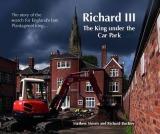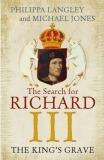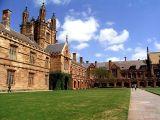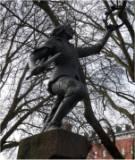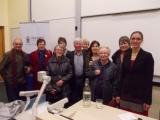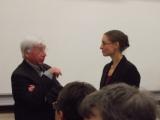Helen Cox, author of two excellent books on the Battle of Wakefield, shares with us her views about the issue of where Richard should be reburied, While she brings some welcome balance to the controversy, we would like point out that these are her views and do not necessarily reflect the views of all members of the NSW Branch or even the Richard III Society as a whole.. We are very grateful to Helen for making this article, which was first published on her blog, Helen Rae Rants!, available to us. You can find out more about Helen on Herstory Writing & Interpretation.
As anyone watching the news, reading the press or visiting social forums will know, the discovery of Richard III’s remains under a car-park in Leicester last year has sparked a war of words as bitterly waged as any medieval battle. Practically from the moment his skeleton was unearthed, the tides of invective began to flow. An early target was Philippa Langley, a long-standing member of the Richard III Society whose years of research, lobbying and fund-raising had enabled the excavation project to go ahead in the first place. ‘Only in it to big herself up and get on TV,’ sniffed some folk of Ms Langley’s painstaking historical detective work. Hmm… is that the rank whiff of sour grapes I smell? Me, I think she deserves a medal for her efforts and the contribution she’s made to Ricardian history.
Worse was to come when the vexed question of where to re-inter the king’s remains arose. The poor Dean of York and President of the Richard III Society received abusive communications from the pro-York camp simply for trying to take a neutral, objective stance on the issue. The Chief Executive of the American Richard III Foundation was derided for her passionate advocacy of York because ‘what’s it got to do with Yanks, anyway?’ The Richard III Society was accused of Machiavellian plotting, cover-ups and withholding information from members. The motives of many individuals concerned with the project, including the Mayor of Leicester, were publicly impugned in such terms that it’s a wonder nobody ended up in court for slander or libel. Venom has dripped from the pages of Facebook and sundry news sites. Altogether, it hasn’t been pretty – and frankly, I’m amazed I’ve escaped the vitriol after some of the stuff I’ve blogged on here. (ie. Helen Rae Rants!)
But now, at last, someone has effectively presented the case for a York re-burial. Yes – in the latest Ricardian Bulletin, (journal of the Richard III Society), David Johnson lays out the reasoning in a well-researched, eloquent letter mercifully free from the inaccuracies and hysterical over-statements that have bedevilled the arguments of some other York supporters.
I might challenge his statement that there is an ‘overwhelming public view that Richard should be laid to rest in [York] Minster’. It depends on the public you’re asking. The Plantagenet Alliance’s on-line petition for a Parliamentary debate on the matter closed with 31,260 names – almost 70,000 short of the 100,000 it needed; another petition for a York re-burial closed with 31,340 names – I’d call that distinctly under-whelming. Meanwhile a rival petition for Richard III to remain in Leicester has 33,247 signatories with three days left yet to run… so I think it’s fairer to say that public opinion is divided.
Otherwise, David Johnson’s letter is highly persuasive. It draws on the Privy Seal Register and Fabric Rolls of York Minster to argue that Richard III’s intention to found a college for 100 chantry priests, with six altars erected within the Minster for their use, parallels his brother Edward IV’s creation of St George’s Chapel at Windsor, and for the same reason – to make a new royal mausoleum. That the sources contain no mention of a tomb, or plans for a chapel to house a tomb, can be explained by the fact that the project was still in its infancy at the time of King Richard’s death.
It’s the best justification I’ve yet seen, and Johnson may well be right that if Richard III had lived out his full span, he would have expected to lie in York Minster. However, one problem is that it still doesn’t prove this was the case; we’re still second-guessing the intentions of someone who died over 500 years ago. And what might those intentions have been on the eve of Bosworth? Richard had the advantage, the ordnance and the larger army of home-grown soldiers to pit against Henry Tudor’s Welshmen and foreigners. I assume he expected to win, kill his rival and hang on to his crown; but it would seem strange if a soldier so experienced in the uncertain fortunes of war hadn’t at least considered the alternatives: that the battle might be indecisive, leaving them both alive to re-group and continue the campaign; or that he would himself die, if not on the field then later, as a defeated captive.
What then of his posthumous fate? Could he trust a new regime to honour his last wishes, if he made them explicit – or to take spiteful pleasure in thwarting them? To what degree, under those circumstances, did Richard III actually care what became of his body, beyond a conventional hope that it would lie in consecrated ground rather than in a mass pit on the battlefield? If he made a will, or issued any form of instruction, it either has not survived or has not yet been found. If he did not, what does that say about his state of mind – that he was sublimely over-confident of victory? That he didn’t want to ‘tempt fate’? Or that if he could not live as King of England, he was not greatly concerned about anything else?
David Johnson ends his letter by saying, ‘one assertion we can make with absolute certainty is that Richard III never chose to be buried in Leicester’. Or can we? It may not have been a positive choice, but one by default; he may have assumed that, in the event of his death, he would end up in a nearby village churchyard (like Lord Dacre of Gilsland, killed at Towton and buried in Saxton) – or in the nearest major settlement to Bosworth…
Of course, I don’t know – but the point is, nobody knows, conjecture as we will. The only things I am certain of is that the battle for Richard III will go on, ironically fought by larger armies than he or any other king could have commanded at the time; and that whether the decision goes with Leicester Cathedral or York Minster, I’ll be shedding no tears (except a few for Richard himself) – I’m just too pleased that he’s going to get a proper tomb somewhere, at last.
Tags: Leicester, Reinterment, Richard III, York
 The University of Leicester Alumni Lecture 2013 – “The Search for Richard III” was given by Mathew Morris and Dr Turi King. Both are graduates of the University of Leicester and of course leading members of the Greyfriars project, as Fieldwork Director and Project Geneticist respectively.
The University of Leicester Alumni Lecture 2013 – “The Search for Richard III” was given by Mathew Morris and Dr Turi King. Both are graduates of the University of Leicester and of course leading members of the Greyfriars project, as Fieldwork Director and Project Geneticist respectively.